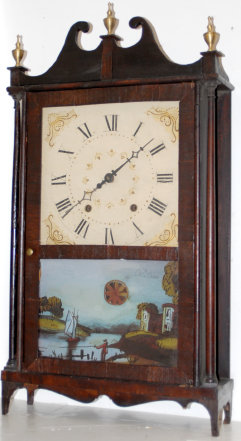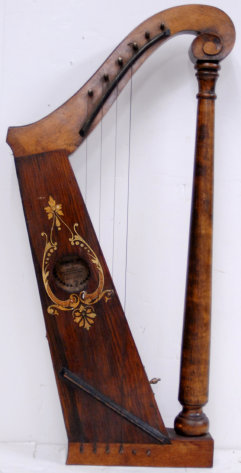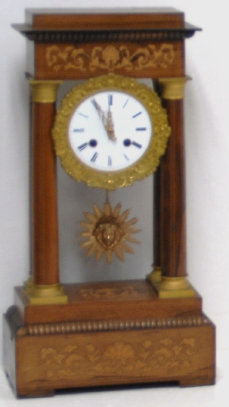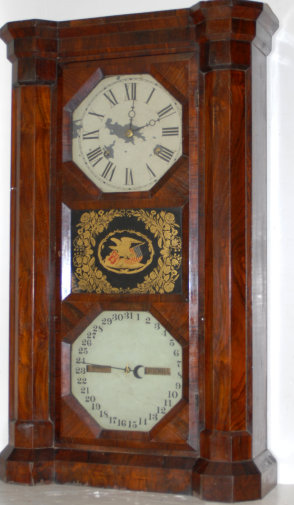
160. $200
French 4-column Empire clock, ca 1890. “F.A.E.que / E. Chatelain / Horlogeries”, stamped on the 8-day movement plate, which would date the clock around 1890. Brown (walnut color) wood case is 16.5” tall, has inlaid designs on the front and on the base below the pendulum. The inlays are perfect. There are ripple like moldings around the top and base. The case is clean and should need no case work. There is a very nice cast bronze sash around the one piece porcelain dial. The dial is good with very faint hairlines. The dial is signed but I cannot make it out. Original French hands and a replaced, proper type pendulum. Four turned columns with bronze capitals and bases. A very attractive clock that runs and strikes a bell on the hours and half hours. $300-$500.

161. $250
Automatic Harp by “The Ward-Stilson Co. New London, Ohio”, ca 1880. There are six strings on
a stained wood case with tri-chromate transfer decoration. This is their model #9582. They made other harps with different string
arrangements. The on/off music box lever is near the base of the harp and it is playing one song. Underneath the base is a paper label
stating the name of the tune being played. The label inside is complete as are other parts of the music box and case, except there
are two missing guitar type strings on the outside that are just for looks. You can buy those strings at any music store. The music
box in the bottom of the case winds on the back of the case. This may be a well know company in middle America but their Harps were
very rare. $250-$350.
159. $250
“Chauncey Ives / Bristol, Connecticut”, pillar and scroll clock, ca 1824. 30-hour time and
strike weight driven wood movement strikes on an iron bell each hour. The clock has been serviced and is in running condition. It
has old iron weights, old pendulum bob and hands. The wood dial is excellent. Inside the case is practically a complete and very large
paper label. The door has had some work done on the wood frame and both glasses are new. The mahogany case is 30 ½ inches to the top
of the modern brass finials. The scrolls and base are new. On top there are period metal covers over the wood rollers. $300-$500.


162. $350
French Industrial Series clock, copied from originals made in the 1800’s. The French companies
produced several different styles of the Windmill and they are still popular today. The windmill blades wind different from the clock
movement. The movement that drives the windmill is inside the door at the base. You open that door to wind the windmill blades. The
case is metal, some parts silver plated, some brass, and some painted brown. Like the French originals this one has a thermometer
on each side and a barometer above the clock dial. It has an 8-day time only clock movement. It is 20 inches tall to the top of the
weathervane. If you are like me and drool over the French Industrial Series clocks but would never fork over the money for one, you
will enjoy this windmill and its very reasonable minimum price. $400-$550.


163. $650
Seth Thomas / Plymouth Hollow, Conn., “8-day Parlor Calendar”, ca 1863. One of three early perpetual calendar models produced by Seth Thomas. They purchased the patent rights to this movement in 1862 and used the calendar movement in a shelf clock they were selling the same year, named simply, “Parlor”. You could buy the clock with or without a calendar. The 30.5” rosewood cases were designed with two large columns on the side, one door, and three glasses. This case has two very good labels and a key locking door. The door is beveled all around and the trim around all three glasses is beveled. Every part of the case is slanted and angled making a very attractive design. The running movement is 8-day, lyre shaped, signed, and running with two large iron weights that appear to also go with their earlier shelf clocks. Original dials, the top has some flaking. The calendar movement, roller papers, pendulum, coil gong, and hands, all are original or period. The center painted glass is excellent and original. Overall in good condition and a good example of their earliest calendar clocks. Ly-Calendar, page 258. $750-$1000.


164. $500
French Meissen, a hard-paste porcelain, kiln fired case that might have been made as early as 1720.
The round 8-day movement however is signed, “A-1”, which dates it to the “Reign of Terror” era, 1780-1790, when French movements were
not allowed to have names inscribed, but only a letter and number. This large, delicate case might be almost 300 years old and I can
only find one small flaw among the hundreds of tiny flower pedals and other ornaments. The many French companies developed markings
to identify their work. This clock has one of the oldest trademarks in existence, the crossed swords. The company making this clock
was established in 1710, near Dresden and is still in business today as “Staatliche Porzellan-Manufaktur Meissen GmbH”. The case is
22 inches tall, has painted flowers on the sides, cupids painted near the base in front, and three cupid type figures on top. The
little guy on the left is holding what appears to be a boat anchor. A small piece of the anchor is missing and is the only break or
missing piece on the entire case that I can detect. Now if you find one, or more, good for you, I cannot. If that missing piece bothers
you I can tell you where to have it repaired and you would never know it had been broken. The round French movement is typical, it
has a nickel bell attached to the back plate, strikes hours and half hours, and is running but needs checked out for it is not striking
properly. $750-$1500.